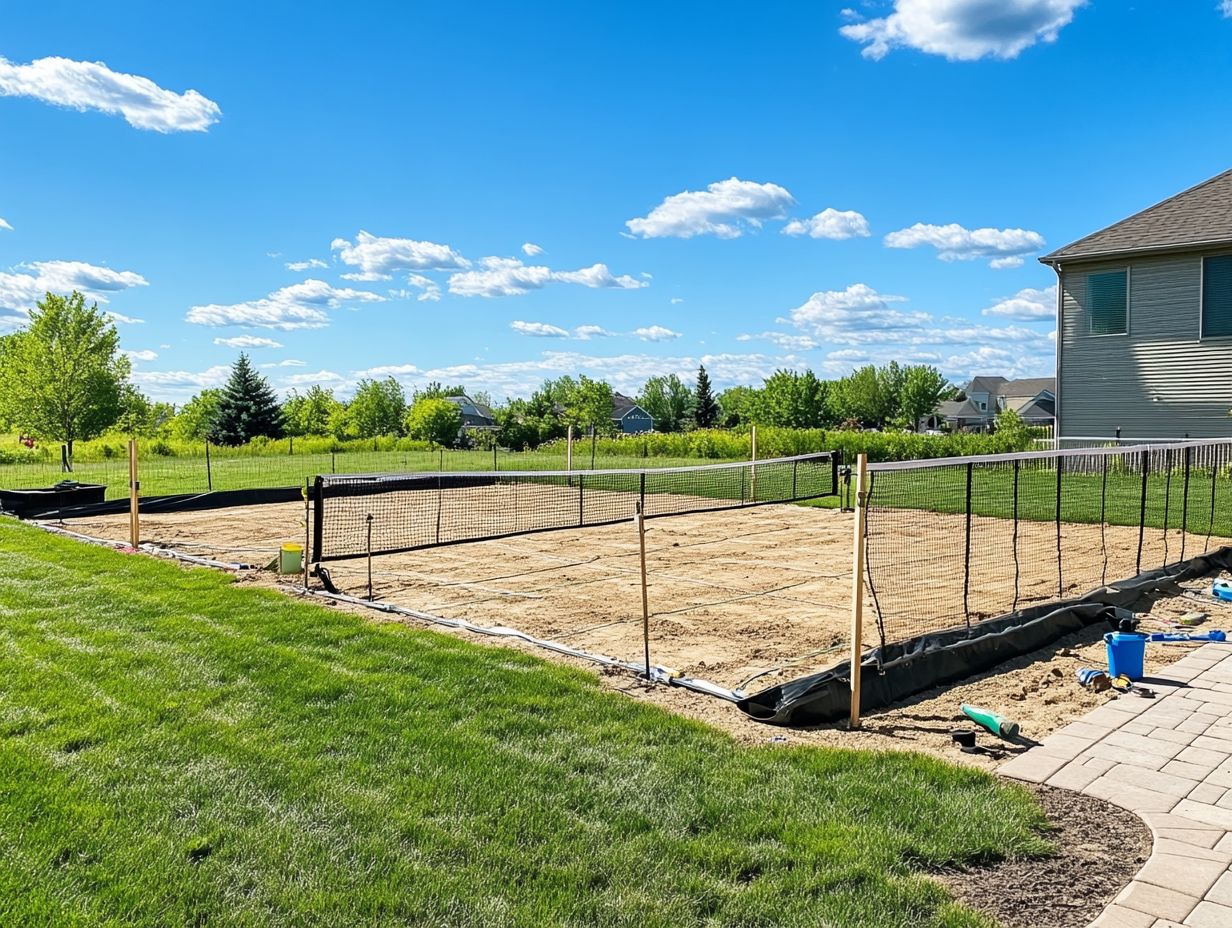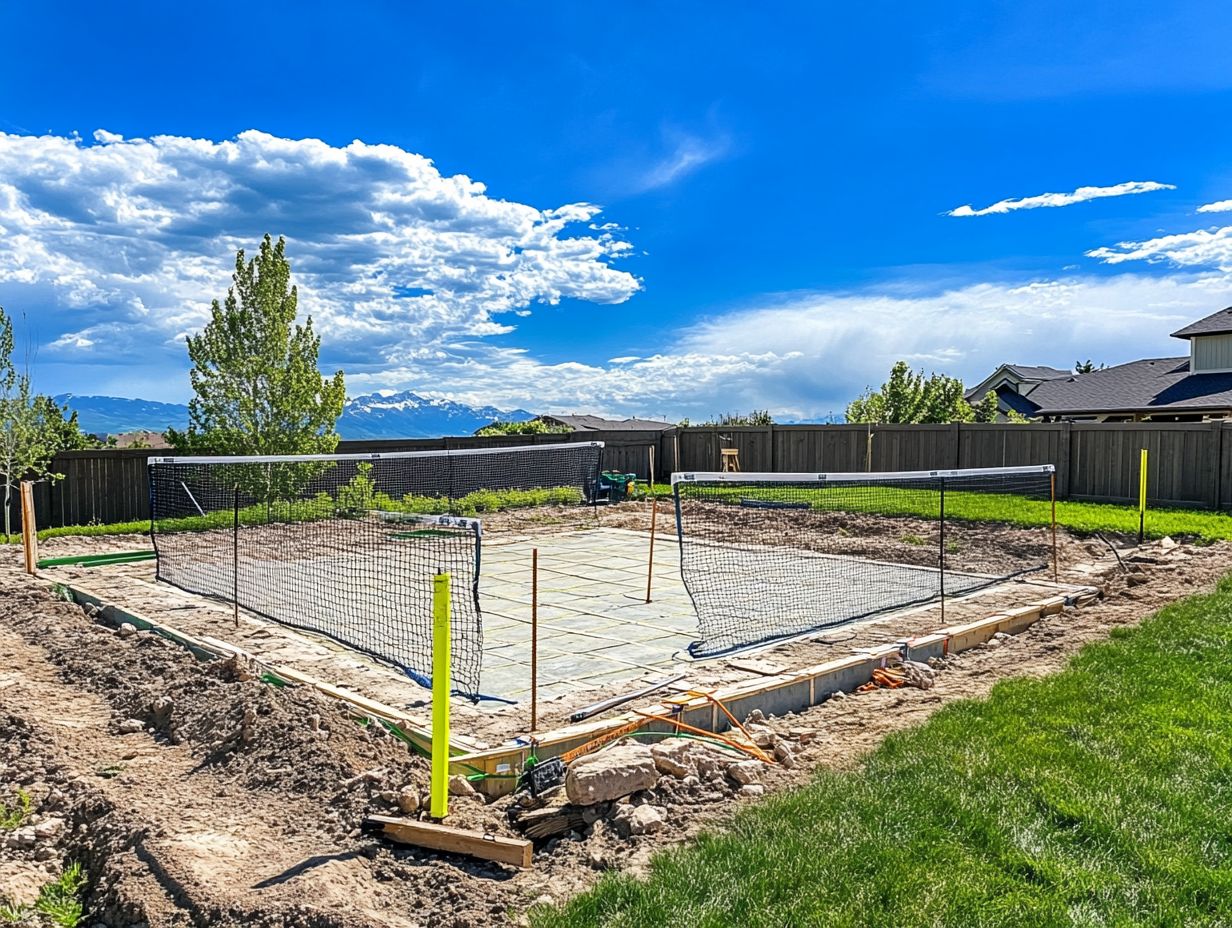Pickleball is an engaging and fast-paced sport that combines elements of tennis, badminton, and table tennis. It is an excellent choice for families and players of all skill levels looking to build a backyard court for fun and fitness. This DIY project not only creates a space for playing pickleball but also fosters social gatherings and community sports, enhancing family bonding, social interaction, and overall health.

Originally invented in the mid-1960s as a game to entertain children, pickleball has since evolved into a national pastime enjoyed by people of all ages. Its appeal lies in its simple rules and ease of play, allowing everyone from beginners to seasoned athletes to participate and have fun.
A backyard court enables families to spend quality time together while getting exercise. Players can engage in friendly games or host tournaments, which helps strengthen community ties. Building a backyard court can be a rewarding project where families collaborate to customize their space, creating a dedicated area for sports and activity.
Choosing the Right Location for Your Court
Selecting the ideal location for your backyard pickleball court is crucial to ensuring a satisfying playing experience. Key factors such as accessibility, sun exposure, and player comfort significantly contribute to the enjoyment of this fast-paced game.
Thoughtful site preparation can enhance playability and ensure proper drainage, making it essential to assess the ground and surrounding area before beginning construction.
Factors to Consider and Preparing the Ground
Ground Preparation: During the ground preparation stage of your backyard pickleball court, several important considerations must be taken into account, including proper ground leveling, effective drainage solutions, and suitable construction materials such as a gravel base and concrete surface. Enhancing the visual appeal and functionality of the court area through landscaping ideas is also essential, ensuring that the necessary space around the court is maintained for gameplay.
A thorough assessment of the terrain should be conducted, and any debris must be cleared away. The soil should be graded to create a firm and flat surface. Adequate drainage is crucial to prevent water pooling, which could damage the court and impair playability; this may involve installing a slight slope or incorporating drainage channels.
The choice of surface is significant; resilient options such as asphalt, concrete, or synthetic materials are all valid depending on your budget and aesthetic preferences. Additionally, you can enhance the visual appeal of the area with decorative features like raised flower beds or low-maintenance shrubs around the perimeter of the court. These elements not only frame the space but also provide shade, contributing to a more inviting outdoor experience.
Materials and Equipment Needed

The materials and equipment needed for a backyard pickleball court encompass both construction materials and surface options, along with the essential items required for play, such as racquets and balls.
Additionally, fencing and lighting are beneficial for backyard courts designed for social gatherings and family fun, whether during the day or at night.
Essential Supplies and Tools for Construction
Building a DIY backyard pickleball court requires careful planning, including the procurement of proper supplies and tools, the establishment of a well-structured construction timeline, and effective budget planning. Additionally, maintenance schedules and cleaning methods are essential to keep the court in good condition for regular use and quality family time.
Before starting construction, it is crucial to assess the land where the court will be built to ensure it meets the necessary dimensions for playing pickleball.
Supplies:
- High-quality court surface materials
- Proper drainage infrastructure
- Marking paint for the lines
are essential supplies for constructing a pickleball court.
Tools:
- Concrete mixer
- Level
- Measuring tape
Construction can be done by hand, but using these tools can expedite the process.
Having a predetermined budget will help prevent overspending, while setting a realistic timeline can mitigate potential delays.
Maintenance:
Regular maintenance schedules, along with cleaning the surface to remove dirt and debris, will prolong the lifespan of your court and enable you to enjoy countless hours of play with friends and family for many years to come.
Building the Foundation
The foundation of your backyard pickleball court—whether it consists of a gravel base, concrete surface, or asphalt surface—is essential for its durability and playability.
Proper site preparation and effective drainage solutions are crucial for maintaining the integrity of the foundation, ensuring that it withstands the elements and stands the test of time.
Preparing the Base and Laying the Foundation

Leveling the ground with appropriate construction materials is essential for creating a solid base for a backyard pickleball court, as it significantly enhances player comfort and performance.
The choice of surface material, such as asphalt or concrete, will ultimately affect the speed of play and the overall experience for participants. A smooth surface is crucial, as uneven ground can lead to erratic ball movement and discomfort for players.
Ensuring a durable base can be achieved through soil compaction and the application of gravel for proper drainage. The ideal pickleball court surface should strike a balance, being neither too slippery nor too sticky, providing just the right amount of traction.
This allows players to maintain grip while also enabling them to move quickly and change direction with ease. By paying careful attention to these aspects of court construction, you can enhance gameplay and reduce the risk of injuries.
Constructing the Court Surface
The court surface is a crucial component of a backyard pickleball court, as its construction significantly affects both durability and playability.
Therefore, selecting the appropriate surface and understanding the installation process is essential. Surfaces like asphalt or concrete provide long-lasting durability while ensuring player comfort during games, making them ideal for recreational use.
Choosing the Right Surface and Installation Process
The surface of a backyard pickleball court is a crucial factor that affects both the durability of the court and the comfort of the players. The primary options for backyard pickleball court surfaces include asphalt, concrete, and specially designed sports surfaces. Knowing how to properly install your chosen surface is essential for creating a level and even playing area that supports effective game strategy and enjoyment.
Asphalt:
- Pros: Low cost, good traction, and easy to repair.
- Cons: Requires periodic resurfacing, traction may decline with wear, and drainage can be poor if not installed correctly.
Concrete:
- Pros: Durable, low maintenance, and provides a smooth playing surface.
- Cons: Higher initial cost, poor drainage, and potential for joint injuries.
Sports Surface:
- Pros: Offers optimal cushioning, reduces impact on players’ joints, lowers injury rates, and can enhance gameplay.
- Cons: Expensive to install and maintain.
Each surface option has its advantages and disadvantages, and the choice of surface will influence both the style of play and the longevity of the court. Therefore, careful consideration is essential for both recreational and competitive players alike.
Adding the Finishing Touches

A well-designed backyard pickleball court enhances the beauty of your home. Adding finishing touches such as in-ground line painting and professional net installation transforms the court from a simple functional space into an attractive area that reflects your personal style.
Choosing color schemes and landscaping ideas that complement your court can elevate not only its aesthetics but also the overall recreational experience.
Painting Lines and Installing Nets
Painting lines and installing nets are two crucial steps in constructing your backyard pickleball court, as they ensure the court adheres to the official rules of play and provides players with a comfortable playing environment. It is also important to carry out these tasks in a manner that facilitates easy upkeep and maintenance for long-term use.
The accuracy of the line markings directly impacts gameplay, as they define the dimensions of the court and offer clear indicators of the game’s rules and boundaries. The net is arguably the next most vital component of the court, as a properly installed net significantly enhances the overall playing experience, fostering a fair competitive environment that is essential in any sport.
However, both of these key elements of a backyard pickleball court require ongoing maintenance, as wear and tear may impact their effectiveness over time. Starting with the lines, it is important to regularly check for dirt and grass buildup, ensuring that the paint remains visible and vibrant. Depending on the frequency of court use, a simple cleaning and periodic application of a fresh coat of paint can greatly enhance visibility.
Regarding the nets, it is essential to inspect them regularly and adjust their tension as needed. Over time, nets may sag, resulting in an uneven playing surface. Adjusting the tension will help keep the net taut and functional, ensuring an optimal playing experience.
Maintenance and Care for Your Backyard Pickleball Court
Regular maintenance and care of backyard pickleball courts include cleaning and seasonal upkeep practices that help preserve the court’s longevity and durability.
Additionally, implementing proper equipment storage solutions contributes to the maintenance of these backyard courts.
Tips for Keeping Your Court in Top Condition
To ensure the longevity of your backyard pickleball court, it is essential to create a regular maintenance schedule that incorporates effective cleaning methods while taking weather conditions into account. Prioritizing player comfort is key in these practices.
Begin by regularly removing debris such as leaves, dirt, and loose stones. Inspecting the court for these materials is vital, as they can obstruct play and cause damage to the surface over time.
Use a soft-bristle broom or a leaf blower to effectively remove unwanted particles from courts made of composite materials or concrete, ensuring that the surface remains scratch-free.
Be mindful of rainy conditions, as standing water can lead to surface deterioration. It is important to dry the court as soon as possible after storms to prevent damage.
Lastly, invest in appropriate cleaning solutions for your specific court surface and perform regular pressure washing to help prevent buildup and maintain optimal conditions for an enjoyable game.

Pickleball’s more than a game to me—it’s a passion. I write, sharing its highs and lows, the thrills and the lessons. Some tales might draw you to the court, while others give a hint of the game’s magic. So, curious about my journey? Ready to dive deep into the world of pickleball with me? Let’s go.
